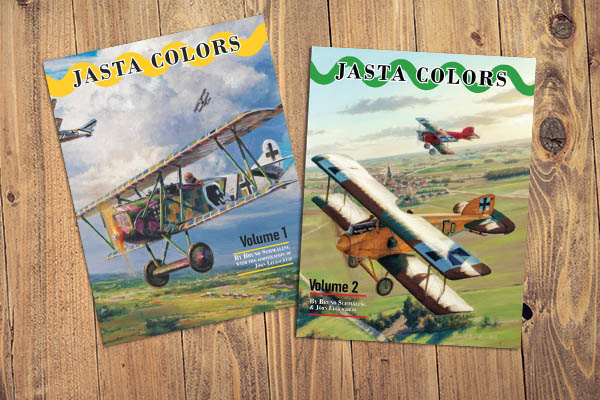
Jasta Colors Volume 1 and Volume 2
By Matt Bittner
Jasta Colors Volume 1
Author: Bruno Schmäling and Jörn Leckscheid
Publisher: Aeronaut Books
ISBN: 978-1-953201-00-3
Binding: Softcover
Pages: 274
Jasta Colors Volume 2
Author: Bruno Schmäling and Jörn Leckscheid
Publisher: Aeronaut Books
ISBN: 978-1-953201-01-0
Binding: Softcover
Pages: 242
It is my opinion that in the world of German World War I aviaition literature, especially when it comes to markings and modeling, these two volumes (and hopefully more to come) are the most important to be released in quite a long time. First, to show what aviator's aircraft looked like based on their own memories, and second, to start showing when personal - and group/squadron - markings started to make their appearance.
Volume 1, Research and Sources for Historians and Modelers is broken out thusly:
Table of Contents
- Prologue
- Traveling Back in Time - The Research Process
- Combat Reports
- Jagdstaffel War Diaries
- Official German report of the "Kommandeur der Flieger"
- Reports in the "Flugmeldebuch" and Reports of Flak-Gruppen-Kommandos
- Orders Given to the Ground Crew
- Pilots Flight Logs and Diaries
- Letters and Notes of the Pilots
- British G-Reports
- Allied Reports on the Markings of German Airplanes
- Contemporary Reports in Newspapers and in Other Pubilcations
- Testimonies made by Pilots and Ground Crew Members after World War I Concerning the Painting Details of the Aircraft
- Publications and Newsletters by Jadgstaffel Members
- Written Testimonies and Memories of Pilots and Ground Crew Members
- Handwritten Notes of Interviews with Jagdstaffel Members
- Taped Interviews with Former Members of Jagdstaffeln
- Paintings, Drafts or Scale Models Done by the Pilots After the War
- Information in Books and Newspapers
- Information Provided by Relatives of Former Jagdstaffel Pilots
- Photo Documentation /Photo Albums
- Grey Scale Interpretation
- Addendums
- Endnotes & Sources
As you can see just in the outline of the Table of Contents, Volume 1 deals a lot with the pilots and their speficic schemes. For example, it is here where we know for sure that Victor Schobinger's Albatros D.Va had an underside-blue, tear-drop stripe on the fuselage sides of his aircraft, and not white as was previously thought. This is based on the interview the author had with the leader of Jasta 12.
Volume 2, Evolution and Background of the Markings Summer 1914 - Winter 1916/1917 is broken out thusly:
Table of Contents
- The Authors
- Collaborators
- Acknowledgement
- Preface
- Introduction
- Prologue
- Airfield of a German Jagdstaffel in Northern France in October 1914
- Preliminary note
- The German Fliegertruppe in 1914
- Examples of the Individual Markings of Aircraft in 1914
- The German Fliegertruppe in 1915
- Examples of the Individual Markings of Aircraft in 1915
- The German Fliegertruppe in 1916
- Examples of the Individual Markings of Aircraft in 1916
- The Military Reasons for the Colorful Painting of the German Jagdstaffeln
- Indentification of the Aircraft of the Pilot's Own Jagdstaffel
- Confirmation of Aerial Victories
- The Different Air Combat Conditions
- The Letter- and Number Markings of the First German Jagdstaffeln
- The Markings and Painting of the First 10 German Jagdstaffeln Autumn 1916-Winter 1916/1917
- Royal Prussian Jagdstaffel 1
- Royal Prussian Jagdstaffel 2
- Royal Prussian Jagdstaffel 3
- Royal Prussian Jagdstaffel 4
- Royal Prussian Jagdstaffel 5
- Royal Prussian Jagdstaffel 6
- Royal Prussian Jagdstaffel 7
- Royal Prussian Jagdstaffel 8
- Royal Prussian Jagdstaffel 9
- Royal Prussian Jagdstaffel 10
- Fighter Pilots at Two-seater Units
- Factory finish of the first Halberstadt and Albatros fighters
- The colors of the factory finish of the Halberstadt fighters
- Factory Finish of the Fuselages of the Albatros D I, D II and D III
- Endnotes
- Sources
Volume 2 deals more with the general application of camouflage as a whole for the entire German air force. Yes, there are specific pilot examples, but only to further the research. In addition, there are also profiles and corresponding text for uniquely finished machines; for example the cloud-painted, overall blue Halberstadt D.II flown by Ltn. Theodor Rumpel. Definitely one I want to model.
All in all, I feel these are necessary books when dealing with the German air force of WWI and how their planes were finished. Not only lots of color fodder for modeling, but also a general idea of how - and why - the German pilots finished their aircraft as they did. Highly recommended.
Huge, HUGE thanks to Aeronaut Books for these to review. Contact them direct for ordering information.
